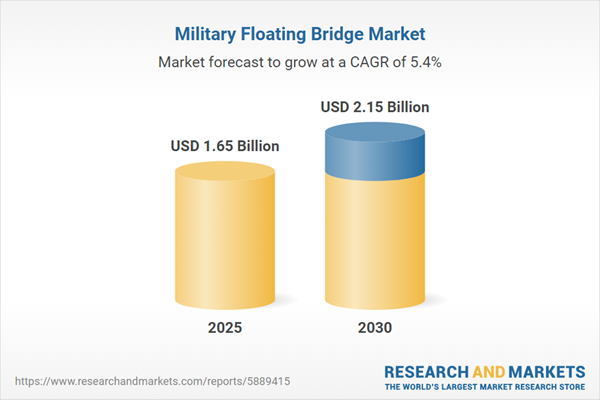Speak directly to the analyst to clarify any post sales queries you may have.
The military floating bridge market is gaining momentum as defense organizations seek adaptable solutions that boost operational flexibility and mitigate infrastructure vulnerabilities in evolving mission environments.
Market Snapshot: Military Floating Bridge Market Size, Growth, and Outlook
The global military floating bridge market is undergoing steady expansion, driven by increasing defense investments and the strategic need for agile logistics. In 2024, the market is valued at USD 1.57 billion, with projected growth to USD 1.65 billion in 2025, representing a 5.51% CAGR. By 2032, forecasts indicate a rise to USD 2.41 billion. Key dynamics shaping the sector include the shift toward modular, rapidly deployable bridge platforms; new systems engineered for multi-domain operations; and a marked focus on solutions that align force mobility with logistical and durability demands. Industry leaders are pushing boundaries in modular engineering and the application of emerging materials to meet operational mandates.
Scope & Segmentation
This research is tailored for procurement and technology decision-makers seeking to evaluate the military floating bridge market from both a tactical and strategic perspective. The analysis provides insight into market composition, technology adoption rates, and pivotal regional considerations, supporting informed procurement and risk management decisions across organizations:
- Mobility Type: Includes pontoon bridges, ribbon bridges, and tank bridge systems designed for fast emplacement and redeployment, meeting the requirements of dynamic combat and humanitarian scenarios.
- Material: Covers aluminum, reinforced steel, and advanced composite materials, each selected to optimize strength, durability, and transport efficiency under demanding operational conditions.
- Payload Capacity: Examines solutions for heavy, medium, and light loads to provide compatibility across diverse military vehicle types and mission profiles.
- End User: Focused on bridge systems tailored for Army, Navy, and Marine Corps applications, aligning with the unique operational constraints and environments faced by each branch.
- Regions Covered: Addresses the Americas, Europe, Middle East and Africa, and Asia-Pacific, analyzing region-specific infrastructure needs, topographical challenges, and the impacts of joint operations.
- Country Coverage Includes: United States, Canada, China, and Germany, each with country-level procurement, regulatory factors, and operational standards influencing local market trends.
- Key Companies: Profiles Mabey Bridge Limited, Parker-Hannifin Corporation, Rheinmetall Aktiengesellschaft, Elbit Systems Ltd., Leonardo S.p.A., BAE Systems plc, General Dynamics Corporation, Dong-Eu Industrial Co., Ltd., Oshkosh Corporation, and Saab AB, highlighting strategic positioning and innovation leadership.
Key Takeaways for Senior Decision-Makers
- Rapid-assembly bridge systems enhance military unit mobility and support mission success in unpredictable or degraded environments.
- Utilization of advanced composites and modular materials enables lighter bridges, which contribute to faster logistics and reduced resource strain over the system lifecycle.
- Integration of digital engineering tools and embedded sensors supports predictive maintenance, providing timely data for maximizing asset reliability and operational readiness.
- Standardized bridging solutions promote interoperability among allied forces, streamlining joint deployment and operational coordination.
- Procurement strategies reflect evolving regional needs, whether focused on amphibious capabilities or terrain-specific adaptability.
- Supplier collaboration and focused technology exchange support evolving defense requirements and help organizations manage acquisition risk in a complex environment.
Tariff Impact and Supply Chain Adaptation
With projected U.S. tariffs entering the landscape in 2025, suppliers in the military floating bridge market are adapting by redesigning systems and diversifying material sources. Ongoing efforts in supply chain optimization, such as enhanced inventory controls and broader supplier networks, are intended to maintain product reliability and budget stability, reducing the impact of potential disruptions.
Methodology & Data Sources
Insights are derived from direct interviews with military engineers and procurement leaders, cross-validated with industry benchmarks for accuracy. This multi-source methodology ensures that findings are both robust and actionable for executive-level decision-making.
Why This Report Matters
- Enables senior defense teams to align procurement planning with current and future bridging needs in the context of rapid technological evolution.
- Offers a comprehensive understanding of technical, regional, and supplier-related variables that directly influence the success of military bridging operations.
- Provides actionable approaches for risk-managed procurement, robust supply chain management, and adaptation to changing defense landscapes.
Conclusion
This report delivers essential insights to help senior leaders choose dependable bridging solutions and strengthen infrastructure resilience in a landscape shaped by dynamic operational demands and advancing technology.
Additional Product Information:
- Purchase of this report includes 1 year online access with quarterly updates.
- This report can be updated on request. Please contact our Customer Experience team using the Ask a Question widget on our website.
Table of Contents
3. Executive Summary
4. Market Overview
7. Cumulative Impact of Artificial Intelligence 2025
Companies Mentioned
The companies profiled in this Military Floating Bridge market report include:- Mabey Bridge Limited
- Parker-Hannifin Corporation
- Rheinmetall Aktiengesellschaft
- Elbit Systems Ltd.
- Leonardo S.p.A.
- BAE Systems plc
- General Dynamics Corporation
- Dong-Eu Industrial Co., Ltd.
- Oshkosh Corporation
- Saab AB
Table Information
| Report Attribute | Details |
|---|---|
| No. of Pages | 193 |
| Published | October 2025 |
| Forecast Period | 2025 - 2032 |
| Estimated Market Value ( USD | $ 1.65 Billion |
| Forecasted Market Value ( USD | $ 2.41 Billion |
| Compound Annual Growth Rate | 5.5% |
| Regions Covered | Global |
| No. of Companies Mentioned | 11 |









